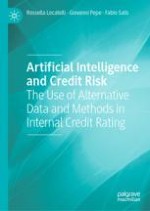2022 | OriginalPaper | Buchkapitel
3. AI Tools in Credit Risk
verfasst von : Rossella Locatelli, Giovanni Pepe, Fabio Salis
Erschienen in: Artificial Intelligence and Credit Risk
Aktivieren Sie unsere intelligente Suche, um passende Fachinhalte oder Patente zu finden.
Wählen Sie Textabschnitte aus um mit Künstlicher Intelligenz passenden Patente zu finden. powered by
Markieren Sie Textabschnitte, um KI-gestützt weitere passende Inhalte zu finden. powered by
